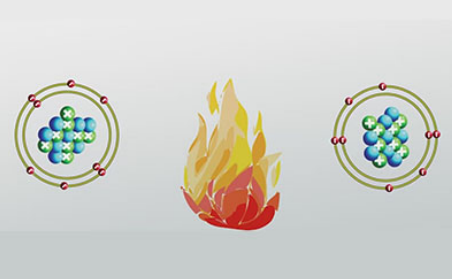
离IGCSE物理考试越近,越是有同学感叹时间来不及。所以本文就来给大家整理热学物理这个重要IGCSE物理考点,希望能帮你留出更多时间去攻克薄弱环节。

IGCSE物理考三张试卷。参加核心课程内容考试的同学,考试卷1、试卷3和试卷5或6。参加拓展课程内容考试的同学,考试卷2、试卷4和试卷5或6。
其中试卷1和试卷2是选择题,有40道单项选择题,考试时间为45分钟,占总分值的30%。
试卷3和试卷4是理论知识题,考试时间为1小时45分钟,满分80分,占总成绩的50%。
试卷5和6是实验知识卷,学员可根据自身情况任选其一。
IGCSE物理考试和国内物理考试最大的区别就是IGCSE物理考点非常广,但是难度并没有很高。因此怎样高效安排复习时间,覆盖更多考点很重要。
热学物理
2.1 Simple kinetic molecular model of matter物质简单分子动能模型
(a) States of matter物质的状态
1-state the distinguishing properties of solids, liquids and gases
描述固体,液体,气体性质的区别
(b) Molecular model分子模型
1-describe qualitatively the molecular structure of solids, liquids and gases
定性的描述固体,液体,气体的分子结构
2-interpret the temperature of a gas in terms of the motion of its molecules
以分子运动来描述气体的温度
3-describe qualitatively the pressure of a gas in terms of the motion of its molecules
以分子运动来定性的描述气体的压强。
4-describe qualitatively the effect of a change of temperature on the pressure of a gas at constant volume
定性的描述体积不变时温度的变化对压强的影响。
5-show an understanding of the random motion of particles in a suspension as evidence for the kinetic molecular model of matter
解释和理解粒子的随机运动 是分子动力学模型的一个实例
6-describe this motion (sometimes known as Brownian motion) in terms of random molecular bombardment
用分子的随机碰撞来描述一种运动(布朗运动)
7-relate the properties of solids, liquids and gases to the forces and distances between molecules and to the motion of the molecules
联系固体,液体,气体的性质与分子间力,分子间距离和分子的 运动
8-show an appreciation that massive particles may be moved by light, fast moving molecules展示一定质量的粒子被光照后移动,并且移动加快。
(c) Evaporation蒸发
1-describe evaporation in terms of the escape of more-energetic molecules from the surface of a liquid
以高能量的分子从液体表面逃离的方式描述蒸发。
2-relate evaporation and the consequent cooling
联系蒸发和冷却结果
3-demonstrate an understanding of how temperature, surface area and wind over a surface influence evaporation
描述理解温度,表面积和表面的气流对蒸发的影响。

(d) Pressure changes改变压强
1-relate the change in volume of a gas to change in pressure applied to the gas at constant temperature
联系温度不变时,体积的改变引起压强的改变。
2-recall and use the equation pV = constant at constant temperature
记住和应用当温度不变时等式,PV=常数
2.2 Thermal properties 热性质
(a) Thermal expansion of solids, liquids and gases
固体,液体和气体的热膨胀。
1-describe qualitatively the thermal expansion of solids, liquids and gases
定性的描述固体,液体和气体的热膨胀。
2-identify and explain some of the everyday applications and consequences of thermal expansion
描述和解释一些生活中热膨胀的实例
3-describe qualitatively the effect of a change of temperature on the volume of a gas at constant pressure mention
定性的描述提到的压强一定时,温度对气体的影响。
4-show an appreciation of the relative order of magnitude of the expansion of solids, liquids and gases说明并展现固体、液体、气体之间膨胀的关系
(b) Measurement of Temperature 温度的测量
1-appreciate how a physical property which varies with temperature may be used for the measurement of temperature and state examples of such properties
赏识一下变化温度的物理性质被用来测量温度并描述一个类似的例子
2-recogize the need for and identify fixed Points
识别和辨认所需要的固定点
3-describe the structure and action of liquid in glass thermometers
描述一个液体温度计的结构和作用
4-demonstrate understanding of sensitivity, range and linearity
说明和理解灵敏度,变化范围和线性
5-describe the structure of a thermocouple and show understanding of its use for measuring high temperatures and those which vary rapidly
描述热偶的结构和理解用它来测量迅速变化的高温
(c) Thermal capacity 热容量
1-relate a rise in temperature of a body to an increase in internal energy
描述一个物体的温度升高内能增加。
2-show an understanding of the term thermal capacity 理解说明热容量
3-describe an experiment to measure the specific heat capacity of a substance
描述一个实验测量一个物体的比热容量。
(d) Melting and boiling 熔化和沸腾
1-describe melting and boiling in terms of energy input without a change in temperature
温度不变时用吸收的能量描述融化和沸腾
2-state the meaning of melting point and boiling point描述熔点和沸点的意义
3-describe condensation and solidification描述液化和凝固
4-distinguish between boiling and evaporation区分沸腾和蒸发
5-use the terms latent heat of vaporization and latent heat of fusion and give a molecular interpretation of latent heat
用蒸发潜热和熔化潜热和给定的分子解释潜热。
6-describe an experiment to measure specific latent heats for steam and for ice
描述一个测量水流和冰的浅比热。
2.3 Transfer of thermal energy热能的传递
(a) Conduction 传导
1-describe experiments to demonstrate the properties of good and bad conductors of heat
描述一个热导体性能好坏的实验。
2-give a simple molecular account of heat transfer in solids
给出在固体中一个简单分子热能的转移。
(b) Convection 对流
1-relate convection in fluids to density changes and describe experiments to illustrate convection
液体密度的改变和转换的关系,描述一个实验解释转换。
(c) Radiation 辐射
1-identify infra-red radiation as part of the electromagnetic spectrum
辨认红外辐射是电磁光谱的一部分。
2-describe experiments to show the properties of good and bad emitters and good and bad absorbers of infra-red radiation
描述一些实验证明红外辐射好的和坏的释放者和吸收者。
(d) Consequences of energy transfer能量转移的结果
1-identify and explain some of the everyday applications and consequences of conduction, convection and radiation
辨认和解释生活中传导,转换和辐射的应用和结果。
3. Properties of waves, including light and sound波的性质包括光和声
3.1 General wave properties普通波的性质
1-describe what is meant by wave motion as illustrated by vibration in ropes, springs and by experiments using water waves
通过用波动的意义解释绳子,弹簧和水波的振动试验
2-use the term wavefront用波振面
3-give the meaning of speed, frequency, wavelength and amplitude
给出速率,频率,波长和幅度的意义。
4-recall and use the equation v = f λ
记住和应用等式速率=平率×时间
5-distinguish between transverse and longitudinal waves and give suitable examples
区分横波和纵波并且举出合适的例子。
6-describe the use of water waves to show用水波描述
(i) reflection at a plane surface平面反射
(ii) refraction due to a change of speed折射由于速率的改变。
(iii) diffraction produced by wide and narrow gaps
通过宽的或窄的缝隙产生衍射。
7-interpret reflection, refraction and diffraction using wave theory
用波的理论解释反射,折射和衍射。
3.2 Light光
(a) Reflection of light 光的反射
1-describe the formation, and give the characteristics, of an optical image by a plane mirror
描述形成,给出特点在平面镜中呈现的光学图像。
2-use the law angle of incidence = angle of reflection会用入射角等于反射角
3-perform simple constructions, measurements and calculations
IGCSE物理考点要求能演示简单的结构测量和计算。
(b) Refraction of light 光的衍射
1-describe an experimental demonstration of the refraction of light
描述一个实验解释光的衍射现象。
2-use the terminology for the angle of incidence i and angle of refraction r and describe the passage of light through parallel-sided transparent material
会用术语入射角i折射角r并且描述光通过两个透明的平行板。
3-give the meaning of critical angle
给出一些重要角度的意义。
4-describe internal and total internal reflection
描述内部的和总的反射
5-recall and use the definition of refractive n in terms of speed
记住和应用以速度定义折射率n.
6-recall and use the equation sin i /sin r = n 记住和应用等式sin i/sin r=n
7-describe the action of optical fibres 描述纤维光学的作用。
(c) Thin converging lens 薄的汇聚透镜
1-describe the action of a thin converging lens on a beam of light
描述薄聚焦透镜对一束光的作用。
2-use the term principal focus and focal length
会用主焦点和焦距。
3-draw ray diagrams to illustrate the formation of a real image by a single lens
用光线图来解释通过单镜头形成的实相。
4-draw ray diagrams to illustrate the formation of a virtual image by a single lens
画光线图来解释通过单镜头形成的虚像。
5-use and describe the use of a single lens as a magnifying glass
用和描述利用一个单镜头作为一个放大镜。
(d) Dispersion of light 光的分散
1-give a qualitative account of the dispersion of light as illustrated by the action on light of a glass prism
定性的分析当光通过棱镜分散的行为
(e) Electromagnetic spectrum电磁波谱
1-describe the main features of the electromagnetic spectrum and state that all e.m. waves travel with the same high speed in vacuo
描述电磁波的主要特点和描述所有的波以同样的速度在真空中传播。
2-state the approximate value of the speed of electro-magnetic waves
描述电磁波速度值。
3-use the term monochromatic
用单一的一色的。
3.3 Sound 声音
1-describe the production of sound by vibrating sources
描述声音是由振动产生。
2-describe the longitudinal nature of sound waves
描述声音的纵向特性。
3-state the approximate range of audible frequencies
描述可听得见波的大概频率。
4-show an understanding that a medium is required in order to transmit sound waves
展示和理解声音的传播需要介质。
5-describe an experiment to determine the speed of sound in air
描述一个测量声音在空气中传播的速度。
6-relate the loudness and pitch of sound waves to amplitude and frequency
声波的响度和音调与振幅和频率之间的关系。
7-describe how the reflection of sound may produce an echo
描述声音的反射产生回声。
8-describe compression and rarefaction
描述压缩和稀疏
9-state the order of magnitude of the speed of sound in air, liquids and solids
描述液体和固体在空气中传播速率大小的顺序。
热血物理相关的IGCSE物理考点就整理到这里。时值3月下旬,冲刺倒计时已开启,大家一定要把握住仅剩的时间认真学习,把自己的薄弱环节及时补上去。如果现在的你离目标分还需加把劲,点击预约试听【唯寻IGCSE复习冲刺班】——
唯寻教学天团授课,
新鲜解题视角,
超强带分能力,
逐级递进梳理重要考点,
知识积累、考试技巧、习惯养成,习题训练逐一击破,
稳扎稳打冲刺A*/9分。

优秀的IGCSE / GCSE成绩是不仅是学好A-level的基础,更是进入英国知名大学的标配,近年来英国牛津剑桥都会要求学员在IGCSE考试中获得5个A或A*,所以IG阶段的复习也是非常关键的。
更多IGCSE / GCSE学习攻略点击

学习有方法,成长看得见
筑梦牛剑/G5/常春藤
